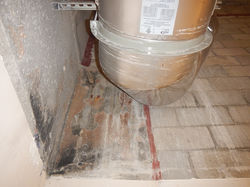CAPITAL ENVIRONMENTAL ASSETS
Environmental Inspections and Project Management
Call now 239-940-0433
Water Damage and Water Loss Inspections
Water damage can be the beginning of many indoor environmental and health related issues. Often water impacted building materials or dampness of building materials can lead to other contaminants other than mold. Contaminants including bacteria, increased insect activity, rodent activity and dust mites to name a few. Mold being one of the primary contaminants associated with water damage brings a long list of potential health related toxins according to the EPA.
According to the EPA's document 'Mold Remediation in Schools and Commercial buildings' "Water damaged materials should be dried within 24 to 48 hours to prevent mold from going through its entire growth cycle.
It is important to have any suspected water loss event inspected and dried soon after discovery. Often water loss will lead to other problems including increased property damage and cost.
If you are a commercial property owner or construction general contractor in charge of a project water damage can often if not always lead to increased costs and product loss. Do not go it alone unless you have specifically trained staff or subcontractors that can identify and remedy the moisture or water loss. Hiring CEA to over see your project or inspect your commercial property during or after water damage has occurred, will help you in the long run to avoid headaches and potential property loss. This can also be applied to home owners, you want to stay safe and healthy and being proactive will always benefit you in the end.
It is also important to control moisture accumulation and condensation associated with high humidity. Humidity moisture related damages can be cause buy many sources including lack of control of humidity, outdoor infiltration of humid air, temperature convergence caused by lack of proper insulating of residential and commercial building structures, prolonged water loss. These conditions almost always result in water damaged building materials and mold growth. According to the EPA to reduce potential mold growth it is recommended to reduce your indoor environment's humidity to 30-60% relative humidity. CEA as part of the assessment will always check factors relating to humidity, air conditioning and humidity control to determine conditions conducive to mold growth and other potential contaminants.

Let us know how we can help.
 Water Intrusion into Buildings |  Carpet Tack Strip Staining |  Condensation related Mold Growth |  Flood Damage to New Construction |  Water Impact to New Materials |
|---|

